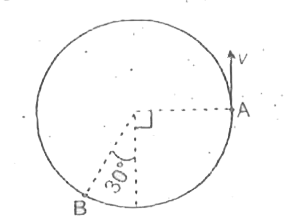A particle of mass m moves with constant speed v on a circular path of radius r. Find magnitude of average force on it in half revolution.
To find the magnitude of the average force on a particle of mass m moving with constant speed v on a circular path of radius r during half a revolution, we can follow these steps:
Step 1: Understand the motion
The particle moves in a circular path with constant speed v. During half a revolution, the particle will move from one point on the circle to the opposite point.
Step 2: Determine the change in velocity
The initial velocity vector →vi can be represented as:
- At the starting point (let's say at the top of the circle): →vi=v^j
After half a revolution, the particle reaches the bottom of the circle, where its velocity vector →vf is:
- At the bottom point: →vf=−v^j
Step 3: Calculate the change in velocity
The change in velocity Δ→v is given by:
Δ→v=→vf−→vi=(−v^j)−(v^j)=−2v^j
Step 4: Determine the time taken for half revolution
The time t for one complete revolution is given by:
t=2πrv
Thus, the time for half a revolution is:
thalf=t2=πrv
Step 5: Calculate the average acceleration
The average acceleration →aavg is defined as the change in velocity divided by the time taken:
→aavg=Δ→vthalf=−2v^jπrv=−2v2πr^j
Step 6: Calculate the average force
Using Newton's second law, the average force →Favg can be calculated as:
→Favg=m→aavg=m(−2v2πr^j)=−2mv2πr^j
The magnitude of the average force is:
Favg=∣∣→Favg∣∣=2mv2πr
Final Answer
The magnitude of the average force on the particle during half a revolution is:
Favg=2mv2πr
The particle moves in a circular path with constant speed v. During half a revolution, the particle will move from one point on the circle to the opposite point.
The initial velocity vector →vi can be represented as:
- At the starting point (let's say at the top of the circle): →vi=v^j
- At the bottom point: →vf=−v^j
The change in velocity Δ→v is given by:
Δ→v=→vf−→vi=(−v^j)−(v^j)=−2v^j
The time t for one complete revolution is given by:
t=2πrv
Thus, the time for half a revolution is:
thalf=t2=πrv
The average acceleration →aavg is defined as the change in velocity divided by the time taken:
→aavg=Δ→vthalf=−2v^jπrv=−2v2πr^j
Using Newton's second law, the average force →Favg can be calculated as:
→Favg=m→aavg=m(−2v2πr^j)=−2mv2πr^j
The magnitude of the average force is:
Favg=∣∣→Favg∣∣=2mv2πr
The magnitude of the average force on the particle during half a revolution is:
Favg=2mv2πr
Similar Questions
A particle of mass m moves with constant speed v on a circular path of radius r as shown in figure. The average force on it during its motion from A to B is

View SolutionA particle is moving with a constant speed v in a circle. What is the magnitude of average velocity after half rotation?
View Solution
Knowledge Check
A particle of mass M moves with constant speed along a circular path of radius r under the action of a force F. Its speed is
A√rFmB√FrC√FmrD√FmrA particle of mass 'm' moves with a constant speed along a circular path of radius r under the action of a force F .Its speed is given by
A√FrmB√FmrC√FrD√FmrAn object of mass m moves with constant speed in a circular path of radius r under the action of a force of constant magnitude F. the kinetic energy of object is
A12FRBFRC2FRD14FR
A particle moves with constant speed v along a circular path of radius r and completes the circle in time T. The acceleration of the particle is
View SolutionA particle is moving with a constant speed v in a circle. What is the magnitude of average velocity after half rotation?
View SolutionA particle moves with a speed v in a circle of radius R.The x-component of the average velocity of the particle in a half- revolution, as shown in figure−3.76,is:

View SolutionA particle of mass m is moving on a circular path of radius r with uniform speed v , rate of change of linear momentum is
View SolutionA particle is moving with a constant speed in a circular orbit. Find the change in its velocity when it completes half the revolution.

View Solution
